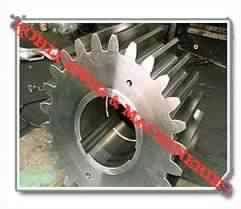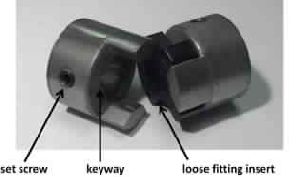
Spur Gear
A gear or cogwheel is a rotating machine part having cut teeth, or cogs, which mesh with another toothed part in order to transmit torque, in most cases with teeth on the one gear being of identical shape, and often also with that shape on the other gear. Two or more gears working in tandem are called a transmission and can produce a mechanical advantage through a gear ratio and thus may be considered a simple machine. Geared devices can change the speed, torque, and direction of a power source. The most common situation is for a gear to mesh with another gear; however, a gear can also mesh with a non-rotating toothed part, called a rack, thereby producing translation instead of rotation. The gears in a transmission are analogous to the wheels in a crossed belt pulley system. An advantage of gears is that the teeth of a gear prevent slippage. When two gears mesh, and one gear is bigger than the other (even though the size of the teeth must match), a mechanical advantage is produced, with the rotational speeds and the torques of the two gears differing in an inverse relationship. In transmissions which offer multiple gear ratios, such as bicycles, motorcycles, and cars, the term gear, as in first gear, refers to a gear ratio rather than an actual physical gear. The term is used to describe similar devices even when the gear ratio is continuous rather than discrete, or when the device does not actually contain any gears, as in a continuously variable transmission.[1] The earliest known reference to gears was circa A.D. 50 by Hero of Alexandria. [2] but they can be traced back to the Greek mechanics of the Alexandrian school in the 3rd century B.C. and were greatly developed by the Greek polymath Archimedes
...more
Spinal Helix Bevel Gear
Spinal Helix Bevel Gear KEM has the expertise to help you select the best power transmission solution for your vessel. From low angles with flex type style to constant velocity design for high angularity, we have the products that will fit your application. Marine power transmission can be complicated and we are very familiar with the convoluted nature of these propulsion systems.Whether it’s a new application or servicing an existing universal joint drive shaft, we stock the products you need and can assemble them for immediate shipment. Our highly trained technicians take pride in finding solutions to your critical requirements.
...more
Jaw Coupling
Jaw Coupling Jaw Type Couplings .Fail-safe - will still perform if elastomer fails.No metal to metal contact.Resistant to oil, dirt, sand, moisture and grease.More than 850,000 combinations of bore sizes.Most types available from stock in 24 hoursThe Jaw Type couplings from Lovejoy are offered in the industry's largest variety of stock bore/keyway combinations. These couplings require no lubrication and provide highly reliable service for light, medium, and heavy duty electrical motor and internal combustion power transmission applications.Applications include power transmission to industrial equipment such as pumps, gear boxes, compressors, blowers, mixers, and conveyors. Lovejoy's Jaw Type couplings are available in 24 sizes from a minimum torque rating of 3.5 in-lbs (0.4 Nm) to a maximum torque rating of 170,004 in-lbs (19209 Nm) and a bore range of .125 inches (4.45mm) to 7 inches (178mm). Lovejoy's standard bore program covers AGMA, SAE, and DIN bore/keyway and spline bore combinations. Lovejoy Jaw Type couplings generally consist of two hubs (available in sintered metal, aluminum, bronze, steel, stainless steel, and ductile iron), and an elastomer element, known as a spider or cushion (materials available include NBR SOX rubber, Urethane, Hytrel®, and Bronze). L Type - Standard Jaw Coupling.Industry's standard shaft coupling.Fail-safe (will still perform if elastomeric "spider" fails).Max Bore: 2.875 inches (73 mm).Max Torque: 12,500 in-lbs (1412 Nm) Jaw Coupling AL Type - Aluminum Jaw Coupling.Lightweight aluminum version of the standard shaft coupling.Corrosion resistant (finished bores passivated for added protection).Max Bore: 1.875 inches (48 mm).Max Torque: 2,268 in-lbs (256 Nm) Jaw Type Stainless SteelSS Type - Stainless Steel Jaw Coupling.Stainless steel version of the industry standard shaft coupling.Interchangeable with L and AL line of hubs (except AL150).Max Bore: 1.875 inches (48 mm).Max Torque: 3,708 in-lbs inches (419 Nm)Type SWSW Type - Radially Removable Elastomer.Standard L type coupling with radially removable elastomer.Fail-safe; plus open center allows for minimal shaft separation.1,750 RPM limit (see LC type for higher limit).Max Bore: 2.125 inches (55 mm)Type LCLC Type - Radially Removable Elastomer.Standard L type coupling with radially removable elastomer.Higher RPM limit (compared to SW) of 3,600 RPM.Fail-safe; plus open center allows for minimal shaft separation.Max Bore: 2.625 inches (65 mm)RRS/RRSC Type - Radially Removable Spacer Coupling.Spacer coupling with "drop out" center for proper separation.Radially removable elastomers (easy installation & maintenance).US and European industry standard pump/motor shaft separations.Spacer made of glass reinforced plastic, cast iron, or aluminumRRC CouplingRRC Type - Radially Removable Spacer Coupling.Larger version of RRS/RRSC type couplings.Spacer coupling with "drop out" center for proper separation.Radially removable elastomers (easy installation & maintenance).Spacer made of glass reinforced plastic, cast iron, or aluminum Jaw CouplingC Type - Higher Torque Jaw Coupling.Greater torque and bore capacity (compared to L type).Fail-safe; plus radially removable elastomeric cushions .Max Bore: 4.000 inches (102mm).Max Torque: 37,800 in-lbs (4271 Nm) Jaw Coupling H Type - Highest Torque Jaw Coupling.Highest torque and bore capacity jaw coupling (more than L & C types)
...more
Industrial Cardan Shaft
A companion flange, sometimes referred to as a hub, allows connection of a flange yoke to another type of connection, for proper torque transfer. The flange yoke is bolted with either through holes or threaded holes to the appropriate companion flange, which has some other form of connection, primarily bore and key or splined input shaft.At KEM we stock a complete line of standard size companion flanges with rough bore that we machine to fit your splined & keyed shafts. We have the capability to bore and key from DIN 58mm to 390mm, and from SAE 1310 to 1950 series, as well as spline bores and cross-serrate flange faces to fit your particular application. We also have machining capabilities that allow us to do special order jobs on material up to 750mm.
...more
Helical Gearbox
Helical Gearbox India Helical gears are similar to spur gears except that their teeth are cut at an angle to the hole (axis) rather than straight and parallel to the hole like the teeth of a spur gear.Helical gears are used to connect non-intersecting shafts. Boston standard helical gears with 45-degree helix angles (a term that will be discussed below) are used to connect parallel shafts or shafts at right (90º) angles. Helical gears are manufactured as both right and left-hand gears. The teeth of a left-hand helical gear lean to the left when the gear is placed on a flat surface. The teeth of a right-hand helical gear lean to the right when placed on a flat surface.Opposite hand helical gears run on parallel shafts. Gears of the same hand operate with shafts of 90º.
...more
Gear Motor Gearbox
Be first to Rate
Rate This